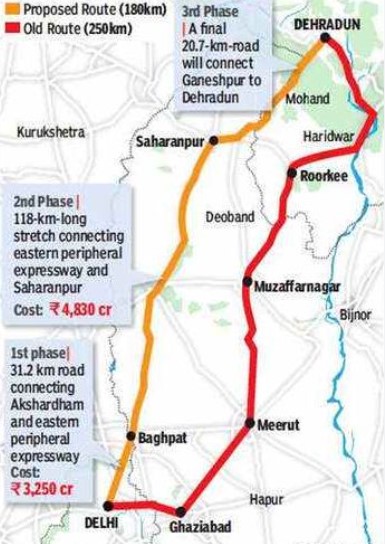Delhi-Dehradun Expressway
The Delhi-Dehradun Expressway is a 210-kilometer (130-mile) long, six-lane access-controlled expressway that connects Delhi, the national capital of India, with Dehradun, the capital of the Indian state of Uttarakhand. It is being built by the National Highways Authority of India (NHAI) and is expected to be completed by December 2024.
Route
The expressway will pass through the states of Delhi, Uttar Pradesh and Uttarakhand, and will pass through the cities of Baghpat, Baraut, Shamli and Saharanpur. It will have two spurs, or link roads, to ensure connectivity with cities lying nearby to its route: one 50.7-kilometer-long (31.5 mi), six-lane Saharanpur–Roorkee–Haridwar Expressway, and another 121-kilometer-long (75 mi), six-lane Ambala–Shamli Expressway.

Features
The expressway will be a six-lane, access-controlled expressway with a maximum speed limit of 120 kilometers per hour (75 miles per hour). It will have a number of features that will make it a safe and efficient road, including:
- Wide medians to separate traffic
- Emergency lanes
- Rest areas
- Toll plazas
Benefits
The Delhi-Dehradun Expressway is expected to bring a number of benefits to the region, including:
- Reduced travel time between Delhi and Dehradun
- Increased economic activity in the region
- Improved safety for motorists
- Reduced pollution
Status
The construction of the Delhi-Dehradun Expressway is currently underway. The first phase of the project, which covers the stretch between Delhi and Saharanpur, is expected to be completed by December 2023. The second phase of the project, which covers the stretch between Saharanpur and Dehradun, is expected to be completed by December 2024.
The Delhi-Dehradun Expressway is a major infrastructure project that is expected to have a significant impact on the region. The project is expected to reduce travel time between Delhi and Dehradun, increase economic activity in the region, improve safety for motorists, and reduce pollution. The project is currently underway and is expected to be completed by December 2024.
Leave a Reply